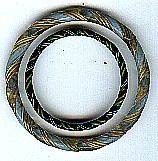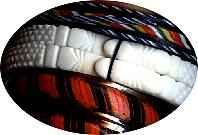|
Married women usually wear red glass ones, but they must be careful buying them. When a bangle breaks, it brings bad luck to her husband. She must replace it immediately so he does not know it happened. Women don't even speak to their friends about this terrible crises. They use euphemisms among themselves such as "my bangle is increasing" or "my bangle is jingling".
We knew a couple from Agra, she an Italian, he a local boy. She made every effort to fit in to her adopted society and was most accomplished at Hindi, local dress and Indian cuisine. He was intelligent and sophisticated and had traveled widely. Yet, he forbade her to wear bangles. She just wanted to be like any other Indian wife. He was afraid of what would happen to him when one broke.
|
Two typical bangle materials.
The insect-made lac, colored red and an ivory bangle for a child.
|
|

Adult and child's twisted glass bangles
|
Today most Indian bangles are made in the corrupt company town of Firozabad by Japanese-introduced methods. However, until recently they were made by beadmakers all around the country.
Bangles are sold in special little shops with walls covered with their multicolored goods. They are also sold by itinerant peddlers (members of bangle-making castes), who carry them in large rectangular frames open on the sides so you can see what he has to sell.
|
|
When archaeologists excavate late 20th century Earth, they'll know they hit the USA when they find a layer of pop tabs and McDonald toys. They'll know Iran by all the plastic bags (or mistake it for Mexico). And they'll know India when they find a layer of broken glass bangles.
If you see an older woman without bangles (and no other jewelry, though she is allowed to keep her gold) you know she is a widow. She broke her bangles (and traditionally all her jewelry) in mourning for her husband.
|

Two fancy glass bangles
with a traditional carved conch shell bangle pair in the center.
|
